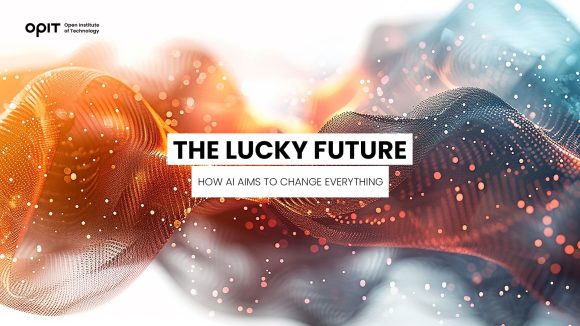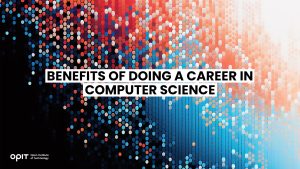

There is no question that the spread of artificial intelligence (AI) is having a profound impact on nearly every aspect of our lives.
But is an AI-powered future one to be feared, or does AI offer the promise of a “lucky future.”
That “lucky future” prediction comes from Zorina Alliata, principal AI Strategist at Amazon and AI faculty member at Georgetown University and the Open Institute of Technology (OPIT), in her recent webinar “The Lucky Future: How AI Aims to Change Everything” (February 18, 2025).
However, according to Alliata, such a future depends on how the technology develops and whether strategies can be implemented to mitigate the risks.
How AI Aims to Change Everything
For many people, AI is already changing the way they work. However, more broadly, AI has profoundly impacted how we consume information.
From the curation of a social media feed and the summary answer to a search query from Gemini at the top of your Google results page to the AI-powered chatbot that resolves your customer service issues, AI has quickly and quietly infiltrated nearly every aspect of our lives in the past few years.
While there have been significant concerns recently about the possibly negative impact of AI, Alliata’s “lucky future” prediction takes these fears into account. As she detailed in her webinar, a future with AI will have to take into consideration:
- Where we are currently with AI and future trajectories
- The impact AI is having on the job landscape
- Sustainability concerns and ethical dilemmas
- The fundamental risks associated with current AI technology
According to Alliata, by addressing these risks, we can craft a future in which AI helps individuals better align their needs with potential opportunities and limitations of the new technology.
Industry Applications of AI
While AI has been in development for decades, Alliata describes a period known as the “AI winter” during which educators like herself studied AI technology, but hadn’t arrived at a point of practical applications. Contributing to this period of uncertainty were concerns over how to make AI profitable as well.
That all changed about 10-15 years ago when machine learning (ML) improved significantly. This development led to a surge in the creation of business applications for AI. Beginning with automation and robotics for repetitive tasks, the technology progressed to data analysis – taking a deep dive into data and finding not only new information but new opportunities as well.
This further developed into generative AI capable of completing creative tasks. Generative AI now produces around one billion words per day, compared to the one trillion produced by humans.
We are now at the stage where AI can complete complex tasks involving multiple steps. In her webinar, Alliata gave the example of a team creating storyboards and user pathways for a new app they wanted to develop. Using photos and rough images, they were able to use AI to generate the code for the app, saving hundreds of hours of manpower.
The next step in AI evolution is Artificial General Intelligence (AGI), an extremely autonomous level of AI that can replicate or in some cases exceed human intelligence. While the benefits of such technology may readily be obvious to some, the industry itself is divided as to not only whether this form of AI is close at hand or simply unachievable with current tools and technology, but also whether it should be developed at all.
This unpredictability, according to Alliata, represents both the excitement and the concerns about AI.
The AI Revolution and the Job Market
According to Alliata, the job market is the next area where the AI revolution can profoundly impact our lives.
To date, the AI revolution has not resulted in widespread layoffs as initially feared. Instead of making employees redundant, many jobs have evolved to allow them to work alongside AI. In fact, AI has also created new jobs such as AI prompt writer.
However, the prediction is that as AI becomes more sophisticated, it will need less human support, resulting in a greater job churn. Alliata shared statistics from various studies predicting as many as 27% of all jobs being at high risk of becoming redundant from AI and 40% of working hours being impacted by language learning models (LLMs) like Chat GPT.
Furthermore, AI may impact some roles and industries more than others. For example, one study suggests that in high-income countries, 8.5% of jobs held by women were likely to be impacted by potential automation, compared to just 3.9% of jobs held by men.
Is AI Sustainable?
While Alliata shared the many ways in which AI can potentially save businesses time and money, she also highlighted that it is an expensive technology in terms of sustainability.
Conducting AI training and processing puts a heavy strain on central processing units (CPUs), requiring a great deal of energy. According to estimates, Chat GPT 3 alone uses as much electricity per day as 121 U.S. households in an entire year. Gartner predicts that by 2030, AI could consume 3.5% of the world’s electricity.
To reduce the energy requirements, Alliata highlighted potential paths forward in terms of hardware optimization, such as more energy-efficient chips, greater use of renewable energy sources, and algorithm optimization. For example, models that can be applied to a variety of uses based on prompt engineering and parameter-efficient tuning are more energy-efficient than training models from scratch.
Risks of Using Generative AI
While Alliata is clearly an advocate for the benefits of AI, she also highlighted the risks associated with using generative AI, particularly LLMs.
- Uncertainty – While we rely on AI for answers, we aren’t always sure that the answers provided are accurate.
- Hallucinations – Technology designed to answer questions can make up facts when it does not know the answer.
- Copyright – The training of LLMs often uses copyrighted data for training without permission from the creator.
- Bias – Biased data often trains LLMs, and that bias becomes part of the LLM’s programming and production.
- Vulnerability – Users can bypass the original functionality of an LLM and use it for a different purpose.
- Ethical Risks – AI applications pose significant ethical risks, including the creation of deepfakes, the erosion of human creativity, and the aforementioned risks of unemployment.
Mitigating these risks relies on pillars of responsibility for using AI, including value alignment of the application, accountability, transparency, and explainability.
The last one, according to Alliata, is vital on a human level. Imagine you work for a bank using AI to assess loan applications. If a loan is denied, the explanation you give to the customer can’t simply be “Because the AI said so.” There needs to be firm and explainable data behind the reasoning.
OPIT’s Masters in Responsible Artificial Intelligence explores the risks and responsibilities inherent in AI, as well as others.
A Lucky Future
Despite the potential risks, Alliata concludes that AI presents even more opportunities and solutions in the future.
Information overload and decision fatigue are major challenges today. Imagine you want to buy a new car. You have a dozen features you desire, alongside hundreds of options, as well as thousands of websites containing the relevant information. AI can help you cut through the noise and narrow the information down to what you need based on your specific requirements.
Alliata also shared how AI is changing healthcare, allowing patients to understand their health data, make informed choices, and find healthcare professionals who meet their needs.
It is this functionality that can lead to the “lucky future.” Personalized guidance based on an analysis of vast amounts of data means that each person is more likely to make the right decision with the right information at the right time.
Related posts

Life is unpredictable. While many of us have specific hopes and expectations of how our futures will turn out, things don’t always go as expected. There are many variables and unexpected incidents that can interfere and force you to alter your plans, and this is particularly true when it comes to education.
For instance, you might have had plans to study a specific subject, but had to deviate from those plans due to unforeseen circumstances. Or you may have had to enter the workforce in an occupation different from the one you sought in an effort to earn an income, a move that may not provide you with the time or opportunity to achieve your desired educational aims.
In short, every individual’s career pathway is different, and very few go exactly as we expect from the outset. Fortunately, even if you experience a few false starts or sudden twists in your pathway, there are always options available to help you get back on track.
The Unpredictable Nature of Education
In theory, the educational process seems simple. You select a course of study that interests you from the vast array of subjects and prospective professions, select the appropriate classes, acquire the knowledge and skills you need to succeed, and then embark on your profession.
In reality, however, as many people know from firsthand experience, the road to education is often far from straightforward. Here are just some of the many challenges that can take your educational path in a completely different direction:
- Life’s Curveballs: As touched on in the introduction, life is impossible to predict. Financial hardships, health issues, and family emergencies are just some of the unfortunate occurrences that might derail even the most perfectly planned educational regime.
- Changing Interests: People’s desires and preferences don’t necessarily stay the same throughout their entire lives. As you grow, learn, and have new experiences, your interests may change, and so, too, may your educational objectives.
- Pressure and Burnout: Some academic paths are particularly challenging, demanding intense levels of study and hard work. This can sometimes prove too much to bear, even for the most resilient students.
- Failures and Setbacks: Conventional education largely builds around tests and examinations, requiring students to demonstrate their competencies repeatedly. It’s a system that doesn’t suit everyone, and test failures can lead to setbacks and delays.
- Inequality: People can be born with very different privileges and levels of access to education. Those in certain parts of the world may find it much more challenging to complete their education path for financial, cultural, or even political reasons.
- Late Bloomers: People develop at different paces. Some may struggle educationally early on in their lives, forcing them to make certain concessions or sacrifices related to their studies, only to find their feet later in life once they’ve entered the world of work.
Whether you’re a late bloomer, have had your educational aspirations delayed by personal problems, desire to learn new skills and try something different, or want to begin a fresh chapter in your professional life, the Open Institute of Technology (OPIT) may be able to help.
Introducing OPIT
OPIT is an online teaching platform, making high-level technological educational programs accessible to all, no matter their age or background. Offering education in fields like computer science, artificial intelligence, and digital business, OPIT provides a curated collection of degrees. In addition, they offer classes taught by world-leading tutors imparting the wisdom and skills students need to achieve their goals and become the tech leaders of tomorrow.
Meanwhile, for those who have had somewhat tumultuous or unpredictable educational paths, OPIT offers the perfect course corrector: the OPIT Foundation Year.
The OPIT Foundation Year
OPIT’s Foundation Year is a Pre-Tertiary Certificate in Information Technology, fully aligned with MQF/EQF Level 4 standards and valued at 60 ECTS credits. Lasting just one year, this program essentially serves as a comprehensive yet accessible springboard towards higher-level education, creating a path towards degrees and careers in dynamic, flexible fields, like computer science and digital business.
Like other OPIT programs, the Foundation Year is delivered entirely online via the OPIT Virtual Learning Environment. Combining live lectures, asynchronous content, and interactive assessments, students enjoy diverse and dynamic study experiences, acquiring core skills like academic writing, mathematics, and computer literacy, and building a bedrock of knowledge and confidence before taking their next steps.
Who Is the Foundation Program For?
The Foundation Program is designed to provide a solid base upon which to build the technological education many students need. It’s the perfect choice for those who are eager and ambitious to enter professions in AI, data science, and computing, but don’t feel that they have the necessary core skills and knowledge needed to dive straight into a degree.
Entry requirements are relatively relaxed in order to allow as many students as possible to enjoy the benefits of this program. With that said, applicants should ideally hold an MQF/EQF Level 3 or equivalent qualification, with the intention of pursuing a bachelor’s degree. A minimum of B2 level of English proficiency is also required, as this is the working and studying language of the institution.
What the Foundation Year Provides
Perhaps you’ve recently graduated, are considering a career change, or finally have the opportunity to return to education after initial delays or unexpected disruptions to your original plans. Either way, the Foundation Year can help you enjoy:
- Greater Self-Confidence: Foundation Year graduates gain the fundamental skills they need to enter degree programs with much more self-belief and assuredness.
- Superior Tech Knowledge: Lasting two terms, this course explores mathematics, academic reading and writing, and provides an introduction to computer hardware and software.
- Foundational Mathematics: Mathematics literacy forms a large part of the study focus for the Foundation Year, helping students feel more comfortable with numbers and formulas.
- Flexible Learning: Unlike more rigid, conventional education environments, OPIT gives you the freedom and flexibility to study at a pace that suits you best, all from the comfort of home.
- Global Community: OPIT is an international institution, with staff and students from all around the world eager to share knowledge, exchange ideas, and help one another.
Take Your Next Steps to Success With the OPIT Foundation Year
If you’re curious about a career in technology or have always wanted to work with AI, data, and computers, but struggled to find the time and opportunities you need to acquire relevant skills and knowledge, the Foundation Program was made for people like you.
It’s the ideal entry point into the exciting world of online education, and the perfect first step towards a prestigious degree from an innovative and increasingly successful institution. Download the brochure to learn more about it, or start your online application, today.

Students today have a broader range of fields of study to choose from than ever before, but with the world becoming increasingly technological and computers increasing in influence and importance, pursuing a career in computer science often proves a smart, strategic choice.
There are numerous benefits and career paths associated with studying and working in computer science, and we’ll be listing just a few of them in this guide.
High Average Salaries
With the rising cost of living in many parts of the world, it’s unsurprising that many students are thinking several decades ahead to determine what level of starting salaries they could obtain in different career fields.
Many are also seeking professions that offer the opportunity for growth and the ability to advance up the ranks over time, thus increasing their salary and their quality of life in the process.
If a strong, stable salary with the opportunity for improved income is one of your top career priorities, computer science should be at or near the top of your list of prospective careers.
According to recent data, computer scientists earn an average of over €65,000 per year, with certain jobs, like IT project leader and data scientist, paying ever higher. Starting salaries are strong, too, with graduates earning anywhere from €46,000 to €60,000, depending on their chosen profession and level of qualifications.
There are similarly high average salaries reported around the world in computer science and related fields such as data science and AI/ML engineering. These numbers are projected to increase in the years to come, pointing to computer science as a way for graduates to get off to the best financial start of any career.
Unrivaled Flexibility
A common problem with some subjects and courses is that they only provide graduates with a narrow set of skills and a similarly narrow range of potential professions to which they can apply those skills.
That’s not the case with computer science. Graduates in this field can enjoy instant access to a remarkably diverse array of career opportunities, with even newer opportunities being created all the time as technology evolves and innovations emerge.
A few of the many industries and roles you might choose to enter in the field of computer science include:
- Healthcare: As a software developer, data analyst, or cybersecurity expert
- Finance: As a fintech engineer, blockchain developer, or security analyst
- Media: As a graphics programmer, AI developer, or game developer
- Education: As an analyst, software developer, or machine learning engineer
Guaranteed Opportunities
Some career paths are more limited than others, with relatively low numbers of opportunities, recurring risks of job loss, or difficulty obtaining employment in the first place.
Again, with computer science, this simply isn’t the case. At a time when 75% of companies plan to embrace AI and other technologies by 2027, and businesses of all sizes and industries are now relying on computers more than ever before, computer science graduates can enjoy almost unbeatable job security.
Opportunities will continue to grow for people with good computing knowledge, whether that be in the obvious fields like software and web development, engineering, and AI development, or more niche sectors.
With so many options, you’re effectively guaranteed a long, rewarding career if you put in the necessary time and effort needed to establish a strong foundation of computing skills.
Rapidly Expanding and Evolving Industries
It’s no secret that the world of technology is a dynamic and fast-moving one. In the past 20 years alone, we’ve seen the proliferation of the internet, the rapid advancement of smartphones and wearable devices, the emergence of AI, and so much more.
In the years ahead, engineers and developers will continue to explore the boundaries of modern technology’s powers and potential, driving new innovations and improvements and opening more exciting job opportunities for those already established and experienced in this field.
Getting into computer science now could therefore provide a solid foundation for a career filled with excitement as you uncover and explore new ways of working with computers in fields as diverse as healthcare, finance, education, entertainment, manufacturing, logistics, and beyond.
Start Your Computer Science Career at OPIT
We’ve discussed some of the many benefits associated with careers in computer science, from the high starting salaries to the rapidly growing array of job options available to graduates. By now, you may be eager to follow this particular career path and take advantage of the wealth of opportunities.
If you’re wondering how to start, the Open Institute of Technology (OPIT) may hold the answers you need. As an exclusively online learning platform, specializing in computer science and digital business, and staffed by some of the world’s leading tech experts, OPIT is producing the tech leaders of tomorrow.
Some of the many advantages of learning with OPIT include:
- Accessible and flexible online education that matches your learning style and schedule
- Heavy focus on real-world applications of the skills you acquire
- An international community of like-minded students from around the globe
- A top team of tutors and lecturers from varying fields and industries
- Progressive assessment of skills and understanding – not constant exams
OPIT offers a small, curated selection of courses for those seeking to gain the technological skills and knowledge to succeed in their chosen areas of expertise. That includes a BSc (Hons) in Computer Science – a six-term program, worth 180 ECTS credits.
Numerous IT industry leaders and experts helped develop this fully accredited undergraduate degree, which is online and accessible to all. Like other OPIT courses, it offers a flexible learning program, with progressive assessments, fast-track options, and the opportunity to be part of a growing community of learners and tutors.
If the benefits of doing a career in computer science interest you, download the OPIT BSc in Computer Science brochure or fill out an online application today and take your first step toward a rewarding and fulfilling profession.
Have questions?
Visit our FAQ page or get in touch with us!
Write us at +39 335 576 0263
Get in touch at hello@opit.com
Talk to one of our Study Advisors
We are international
We can speak in:


